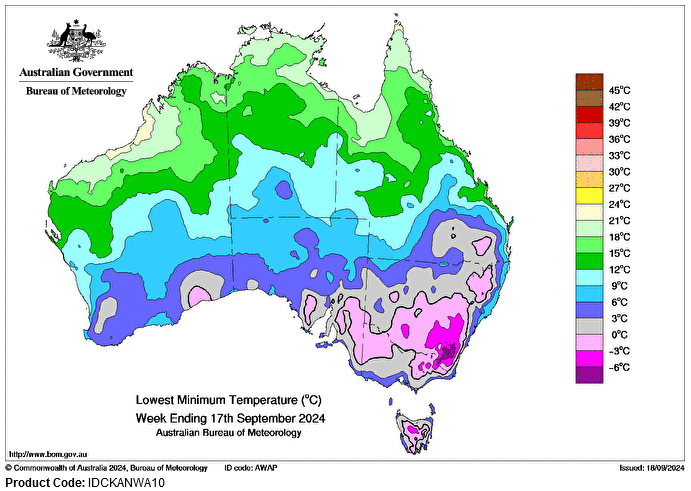Australia: Fierce frost quashes southern selling

Frost in South Australia, Victoria and southern New South Wales on Monday morning has chopped into new-crop production ideas in the southern market.
On top of a dry start to spring, the frost is prompting some growers to drop the worst-affected crops for hay, and many others are nervous about both yield and quality for cereals from the upcoming harvest.
Unfavourable weather into this third week of spring has seen southern growers lose all interest in forward selling.
In the north, traded volume is largely confined to consumers booking a load or two to get them through to new-crop, which will hit the bins in the first half of October.
| Prompt | Sep 12 | New crop | Sep 12 | |
| Barley Downs | $320 | $310 | $302 | $310 |
| ASW Downs | $335 | $335 | $333 | $335 |
| Sorghum Downs | $335 | $335 | $330 | $330 |
| Barley Melbourne | $315 | $320 | $315 | $320 |
| ASW Melbourne | $340 | $330 | $348 | $340 |
Table 1: Indicative prices in Australian dollars per tonne.
Harvest of early barley crops has started in Central Queensland and the Maranoa district, and will move south to the New South Wales border area in the next fortnight.
Volume harvesting of wheat is about two weeks behind barley, and some growers are now expecting above-average rather than near-record yields in the absence of a last grain-filling rain.
“People were talking about bumper crops; now they’re talking about good crops,” one trader said.
Consumers are seen as partially covered into January on wheat, but looking to buy off the header on barley.
“In 10 days, there’ll be a swag of barley coming off.”
Monday morning’s frost event saw temperatures as low as -5 degrees Celsius, and while plenty of crops in south-eastern Australia escaped damage because of their aspect, elevation or moisture reserves, others have been hit hard.
Canola and lentils as well as cereals have all been impacted in areas from SA’s Eyre Peninsula to the NSW Riverina.
Speaking at the Henty Machinery Field Days this week, Intersales Group’s sales manager Trevor Morton said inquiry has been healthy, with hay gear attracting the most interest.
“In the last day or so there’s been a bit of frost and there’s been a bit of interest in spontaneous buying because of possible failed crops,” Mr Morton told the HMFD promoter.
Growers who can now only look forward to very low yields from probably downgraded grain are deploying their own haymaking equipment, or calling in contractors, to get their badly frosted and/or moisture-stressed crops baled.
“We had a light frost on Saturday, a cracker on Monday, and another light one on Tuesday,” Wagga Wagga-based trader Peter Gerhardy of Peters Commodities said.
“I believe there’s a lot of damage done.”
The frost has also burnt off pastures in low-lying areas, and without rain in the next week or two, graziers and mixed farmers will be extending their supplementary-feeding period with their own or someone else’s hay.

Pink shades indicate the scope of recent frost on south-eastern Australia’s grain-growing districts. Source: Bureau of Meteorology
With export values for wheat and barley unimpressive, and consumers comfortable about whopping volumes coming out of central and northern NSW, southern growers looking to wash out contracts for forward sales could well generate demand in the near term.
Mr Gerhardy said growers are hoping for rain by early October, as saved many a crop at the eleventh hour last year, as they weigh up their options on cutting crops for hay instead of carrying through to harvest, or washing out contracts,
“Growers…just don’t know what to do.”
At Young, Focus Grain managing director Michael Jones said growers will have to wait a few days to be able to gauge the impact of Monday’s frost.
“Growers are nervous; this rain forecast for next week will be really important to keep things on track,” Mr Jones said.
Crops from Cowra to West Wyalong and north are generally in excellent condition, and missed the worst of the frost, with only a few hours that got as low as -2, and with more subsoil under the crop.
Mr Jones said most end users are chipping away on October-delivery grain to get them through November, and can then look forward to readily available new crop from December.
“I think they’re fully aware that even if it’s a disappointing harvest here, there’ll be plenty in the north.”
For almost 30 years of expertise in the agri markets, UkrAgroConsult has accumulated an extensive database, which became the basis of the platform AgriSupp.
It is a multi-functional online platform with market intelligence for grains and oilseeds that enables to get access to daily operational information on the Black Sea & Danube markets, analytical reports, historical data.
You are welcome to get a 7-day free demo access!!!
Read also
Merry Christmas and Happy New Year!
Bangladesh to purchase rice, edible oil and lentils to stabilize prices ahead of R...
Ukraine does not claim the money received by Polish or Hungarian farmers – K...
Algeria purchased half a mln tons of durum wheat
Ban on Chinese drones raises concerns among US soybean farmers
Write to us
Our manager will contact you soon



